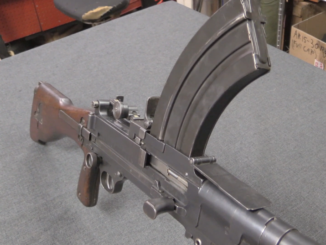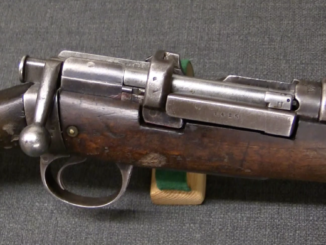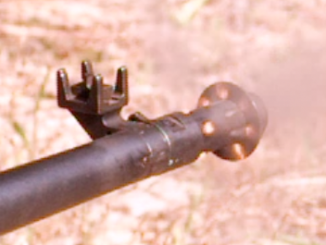The Vickers-Berthier was a light machine gun that competed with the Bren unsuccessfully for British military use but was adopted by the Indian Army. We had the opportunity to handle a pair of them (an early MkI and a later Mk3) at Cornet & Co in Belgium. I will write a more detailed post (or posts) on the Vickers-Berthier coming up, but this video is a decent introduction to the gun:
Related Articles

Light MGs
History and Disassembly of the Vickers-Berthier MkIII LMG
The Vickers-Berthier was initially designed by Andre Berthier in France prior to World War One. It went through a number of substantial design changes before the war, and was actually ordered in quantity by the […]

Bolt Action Rifles
Turkish “Enfauser” – Mauser/Enfield Hybrid Rifle
In the mid 1930s, Turkey updated and overhauled the bolt action rifles in its inventory, to bring them all up to that same standard for sights, ammunition, sling configuration, etc. Most of the rifles overhauled […]

Light MGs
Shooting the Ishapore MkIII Vickers-Berthier LMG
The Vickers-Berthier MkIII was adopted by the Indian army in 1933, and served through World War Two and into the 1970s (at least). It is chambered for the standard .303 British cartridge, fires from […]

Nice to see a more detailed technical presentation on the V-B. It was a very well-made LMG that gave rise to the famous Vickers G.O. (Type K), among others. Although I haven’t seen any recent evidence in writing, it would nevertheless not be surprising if there were still stocks of the V-B mothballed in armories somewhere in India.
What can I say guys? You present it so well, if only I was allowed to buy one….:-(((
Real nice find, bro!!!
What are the Belgian laws regarding automatic firearms?
It looks rather like a Bren gun if Pininfarina had handled the esthetics.
Offtopic: looks like a shop with some interesting stuff there. Too bad its not allowed to take some samples home 🙂
Great video, as always.
I’ve often wondered if anybody had invented a spring-loaded tab like that to strip rounds from the magazine. Given that the bolt usually scrapes along the top round during the ejection-phase, it seems like a good way to reduce friction and stoppages, particularly from 30+ rnd magazines. Any idea if that particular flippy widget worked as intended?
Cheers!
Feeder tabs on bolts are used from time to time. One of the more unusual examples was the .22 Hornet Winchester M54 bolt action rifle.
Like the Win Model 70 which replaced it, the Mod 54 was scaled to take (with a little judicious cutting behind the lower locking lug seat) H&H magnum size rounds, so getting the tiny Hornet to feed was an interesting challenge.
Thanks Keith — you learn something new every day. (Well, I do around here, anyway.)
Seeing this video makes me think Kijiro Nambu was looking at the V-B when designing his magazine-fed light machine guns rather than the Czech ZB-26.
Great video as always.
Sorry for the late reply to this thread — I was in hospital having a heart attack. Not recommended. However, I can recommend the particular hospital (Portsmouth NH) for anybody in similar straits.
The Vickers Berthier has a really great place in special operations history, though. In 1941 when Britain was up against it, they suddenly needed more small arms than the tiny British industry could produce, and the narrowest end of the supply funnel was the mobs-for-jobs or freshly formed special operations units, the Long Range Desert Group (Paddy Mayne), Popski’s Private Army (Vladimir Peniakoff), and Special Air Service (David Stirling). Of the three only the SAS survives, but the LRDG was merged into it after the war, and wartime LRDG operations are still what todays SAS and SF mobility elements study.
The LRDG used trucks (mostly Chevrolet 30-hundredweight or in US parlance, 1 1/2 ton light commercial trucks) and later also jeeps.and armed them with LMGs primarily for defense against the low-flying Luftwaffe.
Since Monty (and his predecessors) were a bit stingy with BRENs and Vickers, the LRDG used a lot of Vickers-Berthier and oddball interwar aerial observers’ machine guns (including Lewises which were resurrected from storage everywhere in the Empire for unconventional, partisan, and maritime use). Along with the 30-round mag (pretty sure not interchangeable with the BREN?) I believe the ground VB could take the drum mag of the intimately related Vickers K (aka VGO) aerial gun. You see photos of LRDG vehicles with single and double mounts of Ks and of VBs. The K was more common.
By the way, I think the design was more or less completed by Berthier (Belgian? Swiss?) and licensed by Vickers. Anybody actually know?
A lot of sources list the same ammo capacity for the VB/VK drums as Lewis drums (47 and 97 rounds) but they don’t look like Lewis drums to me, and an LRDG vet told me (in the Special Forces Club in London, when I used to be a member) that the mags were 100 rounds. (Was he rounding up from 97? Maybe if Ian can turn up the elusive manual we can answer that!)
Hello, Kevin :
I am very sorry to hear about the heart attack. I hope all is well with you now and that you will recover ( and keep ) your full health soon.
With Best Wishes,
Earl
Damn – sorry to hear about the heart attack!
As it happens, I have a couple of Vickers-Berthier manuals, although I haven’t yet read through them seriously. I will be researching a better article on the gun, and will definitely check on the mag capacities (and post the manuals for download as well). The V-B mags aren’t interchangeable with the Bren, although they are generally the same shape. VB mags are distinguishable by a raised rib on their left and right sides.
By the way, where did the aerial guns come from? Simple. The RAF in the middle east decommissioned many types where they sat. As late as early 1939, the service still operated canvas-skinned biplane fighters and bombers even as they rushed modern monoplanes (Hurricanes, Blenheims) into service. Rather than ship them home to England they cannibalized them on the spot. The guns predating the .303 Browning were as obsolete as the biplanes had been, but to ambitious young men with a bunch of trucks to make warlike, they were just the thing.
As a truck gun, about the only thing an M240 has over a VB (or Somme-era Lewis) is a Picatinny rail.
The circumstances surrounding the shortage of available machine guns ( and almost everything else, as well ) for the special operations units such as the LRDG and SAS in the Western Desert at that time actually proved to be fortuitous because these units ended up with really excellent machine guns ( the V-B and Vickers K ) that were accurate and mechanically very reliable in the extremely harsh battlefield environments encountered. The LRDG and SAS also used the Breda 8mm MMG whenever they could capture both the gun and its ammunition for the same reasons. Another illustration of the sort of scrounging that went on can be clearly seen in almost every photograph of SAS jeeps that were armed with the 0.50″ Browning HMG — virtually all the Brownings were of the M2 aircraft variant with a 36″ barrel and perforated cooling jacket rather than the M2HB with 45″ plain barrel.
By the way, the LRDG was founded by Major Ralph Bagnold right around the time Italy declared war on June 10th, 1940 and mobilized an army in Libya. In fact, Bagnold had submitted a proposal just the day before to the then C-In-C Middle East, General Archibald Wavell, for “Long Range Patrols”, which subsequently became the LRDG.
Bagnold was a quiet and unassuming but very efficient officer who had been educated at Malvern College as well as Caius and Gonville College in Cambridge, and who passed through the Royal Military Academy at Woolwich. He served from 1915-1918 on the Western Front with the Royal Engineers, and tranferred to the Royal Signal Corps in 1920. A few years later, he went on duty in the Middle East, fell in love with the desert, and stayed. He began exploring the desert with a few like-minded friends, starting out on weekend trips from Cairo to Siwa Oasis and the Sinai and ending up, by the mid-1930’s, conducting 6000-mile plus expeditions that covered most of the desert between the Mediterranean Sea and Northern Sudan. He perfected the use of the sun compass, sand channels for unsticking bogged vehicles, and accumulated a huge storehouse of knowledge about the region. Oddly enough, the War Office exhibited no interest whatsoever in his exploits, and it was quite fortunate that the Royal Geographical Society continued to support and encourage him. All this knowledge and experience would later be put to vital use by the LRDG and imparted to the SAS ( both units co-operated very closely during the desert campaigns but still retained their unique and separate identities ).
Within a month of Italy’s entry into the war, Bagnold had assembled a cadre of 30 officers and men that would become the nucleus of the LRDG. Legendary names such as William Kennedy-Shaw, Michael Prendergast, Pat Clayton and later Michael Sadler were all part of this team.
Robert Blair “Paddy” Mayne was not in the LRDG ; rather, before being recruited by David Stirling into the fledgeling so-called “L” Detachment of the Special Air Service Brigade ( initially a deceptive unit identification designed to trick the enemy into thinking that parachute units had been assigned to the Middle East ), he had been in No.11 ( Scottish ) Commando. Stirling himself had served in a sister unit, No.8 Commando, before selling the idea of a small, highly-mobile, free-ranging raiding unit to General Neil Ritchie, Deputy Chief-Of-General Staff, Middle East Forces, and subsequently to the General Officer Commanding Middle East Forces, General Sir Claude Auchinleck.
Excellent History indeed, my friend!!! I suppose had Lawrence not been killed on his motorcycle he might well have suggested (and led) such a group…
Thanks, Chris! You are probably right about T.E. Lawrence. Looking at the recent history of the British Empire and Commonwealth, one seems to find so many fascinatingly unorthodox but brilliant and innovative characters within the Armed Forces and Civil Service ( yes, that Civil Service normally renowned for its stodgy but steadfast reliability ), especially in the overseas services where they often “went native” and developed, among other things, a very strong affinity for individuality, the local landscape, its peoples and their culture, and an open mindset that would forever set them apart from their own countrymen.
Earl,
thank you for the correction on Paddy Mayne, and the précis of Bagnold’s seminal role. Most of the “great powers” produced these guys and had a hard time with them in peacetime. I remember some French explorers that traveled North Africa in weird Citroën halftracks between the wars like Jacques Cousteau sailing the 1970s seas… although, “weird Citroén” is a redundancy in engineering terms. US examples included “Red” Carlson of the Marine Raiders, Carl Eifler of OSS Detachment 101, and even Aaron Bank, first commander of Special Forces, who was a by-god pool boy and lifeguard in France between the wars.
But something about the British and particularly the English produced talent far beyond what their little islets could contain. From the eighties through the oughts there were these daily obituaries in the Times and the Telegraph that would leave me shaking my head with wonder that such men lived, and regret that I hadn’t known them.
I have recently begun collecting old autobiographies of forgotten major-generals and such of British colonial wars, as if I didn’t have enough imbalance of years’ reading backlog to years’ life expectancy already. Some of these things read like the Flashman tales, except neither fictional nor tongue-in-cheek. To read about these guys from the Victorian and Edwardian eras gives me a better understanding of where their sons and grandsons in WWII were coming from.
Well said, Kevin, well said. I remember reading as a child about the French desert explorers and some of the horrendous adventures they had. I think there were also a handful of larger-than-life Italians of the same ilk during the same time period in places like Eritrea and Italian Somaliland. History also tends to neglect the subject of the Auto-Saharan companies and the role they played in the Desert War.
Speaking of extraordinary men of that genre we both regret not knowing, how about Sir Ernest Shackleton? Now there’s an outstanding example of real leadership in the face of the most insurmountable possible odds, in every sense of the truth it entails, bar none. Or, a little later in modern history, how about George Mallory, without whose pioneering efforts Edmund Hillary and Tenzing Norgay might not have conquered Everest? There are so many of them, and precious little time in which to truly appreciate and understand their endeavours and the spirit they embodied.
Oh yes — one more thing. The M2HB was not in British service, the ANM2 was, I believe. The British also had a .50 Vickers that fired its own round, 12.7x81mm. Actually they called it the .5″ . Occasionally you see what looks like a Vickers /303 with a thyroid problem on an LRDG vehicle, it’s this guy. They were used on tanks and in multiple AA mounts on land and sea. They were replaced by the BESA in 15x104mm on tanks, and the Oerlikon in 20x100RB for other uses.
I believe the UK adopted the M2HB, but after the war, as the L2A1.
Yes, I had almost forgotten about the 0.5″ Vickers. There’s another gun that Forgotten Weapons could get into at some point, along with the Rolls-Royce 0.5″ HMG and other rarities. One also frequently sees 0.303″ Lewis guns on improvised mounts in old photos of LRDG trucks.
The Browning AN-M2 with the 36″ barrel was better-suited to the HMG role in SAS jeeps than the Vickers because it was lighter and did not require water cooling, along with the attendant logistical problems this entailed in a relatively small vehicle with limited cargo capacity.
The VGO magazines were completely different from the Lewis magazines. The Lewis had a cam and pawl action that advanced the magazine outer drum, and thus the rounds along the helicoid magazine core that was fixed to the gun. The VB had spring-loaded magazines with a design capacity of 100 rounds, but loaded to 97 rounds to avoid spring breakages. Owing to the limitations of available space these springs were compact and very highly strained and made from a special Swedish steel rather than common spring steel. There’s a good book for this kind of info “Guns of the RAF”.
There is also the Vickers F type gun, basically a classical Vickers action with a narrow air cooled barrel jacket and fittings for Lewis magazines instead of a belt feed. The RAF rejected them and the only user seems to have been the Polish Air Force in 7.92 mm Mauser on observation planes before they developed their own gas-operated weapon. I have very little data on this one, and most of that is in Polish…